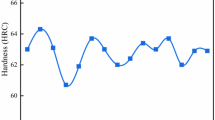Abstract
Current policies on environmental issues put extra pressures on manufacturing processes to be resource efficient and eco-friendly. However, in grinding processes, large amounts of cutting fluids are used. These fluids are not environmental friendly thus require proper management before disposal with associated cost. Hence, this work sets to explore low-frequency vibration in grinding in order to improve coolant application in conventional grinding at the first stage with the aim to introduce this into high efficiency deep grinding (HEDG) at latter stage. An attempt is made to grind nickel alloys with minimum quantity lubricant (MQL) as oppose to flood cooling. To achieve this with minimum alterations to the machine tool, a piezo-driven workpiece holder was developed for surface grinding. This simple innovative workpiece holder allowed oscillating during actual grinding process. However, this paper presents the results of low-frequency oscillatory grinding in dry and near-dry conditions. The response of the machine tool spindle unit is presented alongside with the workpiece holder response. In this investigation, hardened steels and nickel alloys were ground with vibration assistance. The grinding forces are illustrated together with the surface finish. The wheel performance is given in terms of grinding ratio.
Similar content being viewed by others
References
Bespalova LV (1957) The theory of vibro-impact mechanisms. Izvestiya ANSSR, OTN, Moscow (in Russian)
Blekhman II (1979) Vibration of nonlinear mechanical systems, 2nd edn. Vibration in Engineering, Moscow, in Russian
Kumabe J (1985) Vibrating Cutting. Mashinostroenie, Russian translation, Moscow, original in Japanese, 1979
Jiang YX, Tang WX, Zhang GL, Song QH, Li BB, Du B (2007) An experiment investigation for dynamic characteristics of grinding machine. Key Eng Mater 329:767–772
Rowe WB, Mills B, Black SCE (1996) Temperature control in CBN grinding. Int J Adv Manuf Technol 12:387–392
Orynski F, Pawlowski W (2002) The mathematical description of dynamics of the cylindrical grinder. Int J Mach Tool Manuf 42:773–780
Kirpitchenko I, Zhang N, Tchernykh S, Liu D K (2002) Dynamics and control of grinding machines. 6th Int Conf Motion Vib Control Part 2 1039–1044
Zhang B, Hu Z, Luo H, Deng Z (2006) Vibration-assisted grinding—piezotable design and fabrication. Nanotechnol Precis Eng 4:282–290
Zhong ZW, Yang HB (2004) Development of a vibration device for grinding with microvibration. Mater Manuf Process 19(6):1121–1132
Zhong ZW, Rui ZY (2005) Grinding of single-crystal silicon using a microvibration device. Mater Manuf Process 20:687–696
Mahaddalkar PM, Miller MH (2014) Force and thermal effects in vibration-assisted grinding. Int J Adv Manuf 71:1117–1122
Tawakoli T, Azarhoushang B (2008) Influence of ultrasonic vibrations on dry grinding of soft steel. Int J Mach Tool Manuf 48:1585–1591
Babitsky VI, Kalashnikov AN, Meadows A, Wijesundarac AAHP (2003) Ultrasonically assisted turning of aviation materials. J Mater Process Technol 132:157–167
Kozlov A, Deryabin M (2011) Pulsed processes when cutting heat-resistant alloys. Proceedings of the 6th International Congress of Precision Machining, Liverpool UK 13–15 September, Liverpool, pp 47–52
Liang Z, Wu Y, Wanga X, Zhao W (2010) A new two-dimensional ultrasonic assisted grinding (2D-UAG) method and its fundamental performance in monocrystal silicon machining. Int J Mach Tool Manuf 50(8):728–736
Mitrofanov AV, Babitsky VI, Silberschmidt VV (2003) Finite element simulations of ultrasonically assisted turning. Comput Mater Sci 28:645–653
Moriwaki T, Shamoto E (1991) Ultraprecision diamond turning of stainless steel by applying ultrasonic vibration. Kobe University Japan vol.40 No.1
Spur G, Holl S E (1997) Material removal mechanisms during ultrasonic assisted grinding. Prod Eng, IV/2 pp.9-14
Spur G, Holl SE (1996) Ultrasonic assisted grinding of ceramics. J Mater Process Technol 62:287–293
Uhlmann E (1998) Surface formation in creep feed grinding of advanced ceramics with and without ultrasonic assistance. Institute for Machine Tools and Factory Management, Berlin
Mishra VK, Salonitis K (2013) Empirical estimation of grinding specific forces and energy based on a modified Werner grinding model. Procedia CIRP 8:287–292
Salonitis K, Stavropoulos P, Kolios A (2014) External grind-hardening forces modelling and experimentation. Int J Adv Manuf Technol 70:523–530
Filiz S, Cheng CH, Powell KB, Schmitz TL, Ozdoganlar OB (2009) An improved tool-holder model for RCSA tool-point frequency response prediction. Precis Eng 33(1):26–36
Schmitz T, Ziegert J (1999) Examination of surface location error due to phasing of cutter vibrations. Precis Eng 23(1):55–62
Altinas Y, Montgomery D, Budak E (1992) Dynamic peripheral milling of flexible structures. J Eng Ind Trans ASME 114(2):137–145
Erturk A, Ozguven HN, Budak E (2006) Analytical modelling of spindle-tool dynamics on machine tools using Timoshenko beam model and receptance coupling for the prediction of tool point FRF. Int J Mach Tool Manuf 46:1901–1912
Kirpitchenko I, Zhang N, Tchernykh S, Liu DK (2002) Dynamics and control of grinding machines. 6th International Conference on Motion and Vibration Control’ Part 2, pp 1039–1044
Thomsen JJ (2003) Vibrations and stability: advanced theory, analysis and tools, 2nd edn. Springer complexity series, New York
Author information
Authors and Affiliations
Corresponding author
Rights and permissions
About this article
Cite this article
Batako, A.D.L., Tsiakoumis, V. An experimental investigation into resonance dry grinding of hardened steel and nickel alloys with element of MQL. Int J Adv Manuf Technol 77, 27–41 (2015). https://doi.org/10.1007/s00170-014-6380-8
Received:
Accepted:
Published:
Issue Date:
DOI: https://doi.org/10.1007/s00170-014-6380-8




